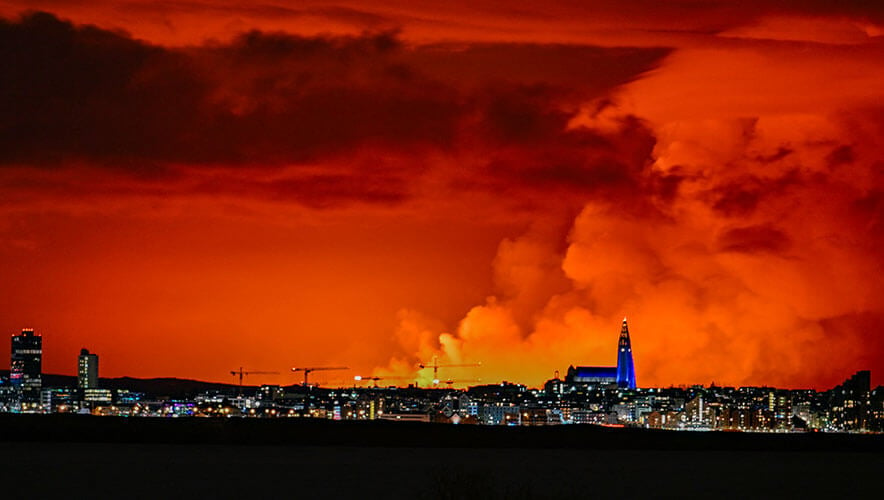Fourth Volcanic Eruption in Iceland Forces Evacuations
A volcanic eruption in Iceland resulted in the evacuation of the area around the fishing town of Grindavik. Although the lava and volcanic activity has slowed, the eruption is ongoing and authorities are monitoring the situation in case lava reaches the southern shoreline.
The eruption, which started during the evening of 16 March, is the fourth to occur in Iceland during the last three months. Spewing from the Hagafell and Stora Skogfell mountains on the Reykjanes Peninsula, the lava flowed toward Grindavik, which has a population of almost 4,000 people.
Authorities issued emergency warnings, declared a local state of emergency, and evacuated the area, including the Blue Lagoon, a popular geothermal spa resort. Although the eruption alert came 15 minutes before the event, it was not a complete surprise because authorities had issued warnings for weeks prior that an eruption was “imminent” in the area, according to Reuters.
“Initial assessments suggested the eruption was the largest of the four recent ones in the area, since swarms of earthquakes caused the Svartsengi volcanic system to awaken for the first time in almost 800 years,” The Washington Post reported.
The eruption has not generated ash, which can interrupt or endanger air travel. Keflavik Airport—Iceland’s main airport located in Reykjavik—remains open for incoming and outgoing flights.
The opening the lava spewed from is estimated to be roughly 2.9 kilometers (1.8 miles) long, according to the Icelandic Meteorological Office (IMO). The last time this volcano erupted was in February and resulted in more than 20,000 people losing their heating, the destruction of roadways, and the evacuation of thousands of people from the area, according to the BBC.
“However, anti-lava barriers outside Grindavik are holding and there has been no damage to critical infrastructure since the eruption,” CNN reported.
Iceland’s Director of Civil Defense Vídir Reynisson told the BBC that while all preparations were completed prior to the eruption, the biggest concern remains the lava’s impact on infrastructure.
Along with worries that the lava may overcome the defensive measures and barriers, “[there] are concerns that fiber optic cables on the road could be damaged—causing disruption to phone and Internet services,” the BBC said.
Lava has flowed slowly towards the south and southeast, meaning it is also flowing in the direction of the ocean. Although the IMO estimates that it is unlikely that the lava will reach the water, it will continue to monitor the lava's progress and plan for this possible outcome until the eruption ends. Although volcanic activity, including lava flow, has slowed, the eruption is not over as of the evening of 17 March, according to the IMO.
“In the event of lava interacting with seawater, there would be a range of volcanic hazards due to the sudden cooling of lava,” the IMO said. These hazards would include the production of gases—largely hydrogen chloride—and “would be potentially lethal” to anyone within a 0.5 km (0.3 mile) radius from where the lava meets the sea, according to the IMO. Another potential hazard is minor explosions if the lava becomes unstable upon coming into contact with the water.










